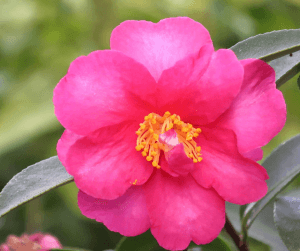CAMELLIAS FOR FALL

I live in a cold winter area, so most of the camellias that I have seen and coveted have been lodged in the comfortable confines of the giant glass conservatories of botanical institutions. The large, evergreen shrubs—generally varieties and hybrids of the Japanese camellia (Camellia japonica) bloom in mid to late winter, covering themselves with a glorious profusion of white, pink, rose, red and bi-colored blooms. Many of those flowers look a little like roses but have little to no scent. The beauty of the blooms more than compensations for that.
Yuletide Camellias
Sasanqua camellias have all the desirable traits of the genus with the added attraction of a different bloom time. Bursting into flower in the fall and early winter, they put on a colorful show long before their camellia relatives. This makes them catnip to gardeners, prolonging the camellia season and easing the wait for the Camellia japonica varieties.
The unique bloom time also gave rise to the species’ nickname, “Yuletide camellia”. As with the similarly named “Christmas rose” (Helleborus niger), the sasanqua’s blooms may not appear on December 25, but will open any time from Halloween through the winter holidays.
Roots in Japan, Flowers Around the World
The sasanqua camellia was introduced to the western world from Japan in 1811 and caught on quickly in parts of North America that lie in USDA plant hardiness Zones 7-9. Those climate restrictions did not deter true camellia-philes from growing the shrubs outdoors in large pots that were overwintered under cover, or simply keeping them year-round in greenhouses or conservatories. More recently, breeders have produced sasanqua hybrids that are more cold-hardy that the species.
Sasanqua vs. Japonica
Given that the two species bloom at different times, are there other ways that sasanquas differ from japonicas? Both are members of Theaceae or tea family, with glossy green leaves. The average sasanqua is somewhat smaller than the average japonica, topping out at six to 10 feet tall compared to its relative’s maximum height of 10 to 15 feet. The young stems are coated with fine hairs, which are not present on japonica varieties. Many experts characterize sansanquas as being more relaxed and refined in appearance than the later blooming camellias. The leaves are smaller and the growth habit more open, giving the plants an airy appearance.
Much-Loved Flowers

Species sasanqua flowers bear six to eight petals apiece and are up to three inches wide when fully open. Those petals surround centers of golden stamens, making them doubly showy. The petals may be crinkled like crepe paper, as in ‘Grey Ghost’, a silvery pink variety. Single, double and semi-double varieties may boast romantic ruffled petal edges, like those of ‘October Magic® Carpet’.
Form and Substance
If you are hunting for a simpatico sasanqua, you can take your pick of flower forms, including plants with blossoms that are almost anemone or peony-like. Many bear Japanese names, in keeping with the long-established breeding efforts in the species’ country of origin. Extensive breeding has also taken place in the United States and elsewhere. ‘Yuletide’ is a true red variety, with a single row of petals surrounding bright gold stamens. Lovely, ruffly ‘Cecilia’ is a white-flowered double that is pink at its heart, with just the slightest hint of the same color on the petal edges. ‘Susie Dirr’, named after the daughter of woody plant guru, Dr. Michael Dirr, is an opulent, pink-flowered double with rounded petal edges.
Showy Leaves
I love the elegant, glossy foliage of the average Camellia sasanqua, but it you are in the market for additional garden interest, breeders have come up with plants that will meet your needs. ‘Golden Phoenix’ boasts pink and white single flowers, accompanied by dark green leaves edged in cream. ‘Royal Flush Shishi™’ features single rose-pink flowers and foliage variegated in shades of light and dark green.
Tolerating Cold
To increase cold-hardiness and other desirable traits, sasanquas are sometimes hybridized with other species, especially Camellia oleifera, native to parts of China, that is also noted for cold tolerance. Hybrids are easily identifiable by the “x” in the plant name, as in Camellia x ‘Winter Waterlily’.
What About Scent?

Not all sasanquas are fragrant, and some have only a faint fragrance, but a little research will yield some scented varieties, like white-flowered ‘French Vanilla’, and the anemone-flowered ‘Scented Snow’.
Happy Home, Happy Camellia
No matter which sasanqua you choose, treat it to the light shade that the species prefers, accommodating the roots with well-drained, acidic soil. If your soil leans towards the alkaline side, amend the planting soil with a product like Fafard ® Premium Natural and Organic Compost. Consistent moisture is necessary, and mulch is helpful- as long as the mulch is applied doughnut-fashion and does not touch the camellia’s trunk. As with other flowering specimens, prune just after the flowers fade. Hard pruning will not traumatize a healthy camellia.
Sasanquas work equally well as single specimen plants or as flowering hedges. The hedge option is especially appealing, because it keeps the floral show going in the late fall, while upholding the tradition of evergreen hedging.
About Elisabeth Ginsburg

